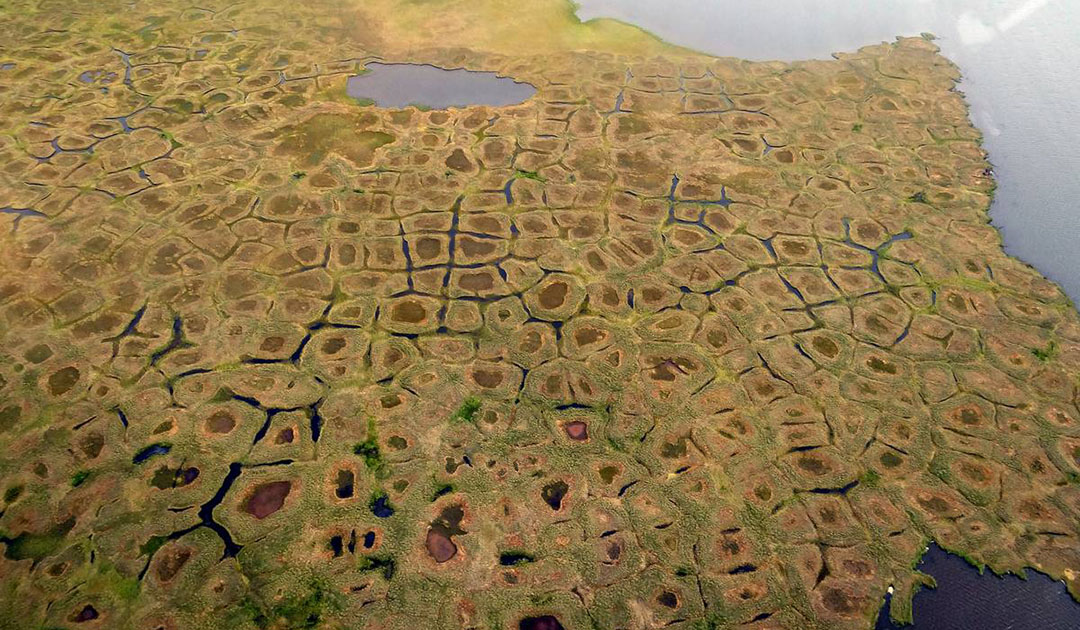
The biologic processes that take place when permafrost thaws is well understood: as formerly frozen organic matter warms, the process of decomposition — set on standby for thousands of years — sets in, releasing the carbon that was once pent up into organic material into the atmosphere in the form of a gas. New research suggests, however, that the amount of additional harm permafrost-thaw may be doing to the climate on top of man-made changes depends on a number factors, including, perhaps crucially, the presence of water.
Understanding what happens to permafrost when it thaws matters — and in a big way — because of the sheer expanse of permafrost and the amount of carbon it could potentially release into the atmosphere. Permafrost covers a quarter of the Northern Hemisphere, and, by some measures, it holds as much carbon as is currently present in the air. Releasing it all at once could result in a massive increase in climate-warming gasses, greatly exaggerating the greenhouse effect.
The authors of a recent paper, published in Global Change Biology, suggest, however, that thawing permafrost is not always a major climate worry. It turns out that, given the right conditions, the emissions of greenhouse gasses may be considerably lower than feared, and, indeed, instead of releasing methane — a powerful, if short-lived greenhouse gas that is produced during decomposition — thawed permafrost may actually trap some of the methane that is already in the air.
Part of the reason for this it that most studies about carbon emissions from thawing permafrost have taken place in areas where the permafrost layer runs deep, making them more resilient to warming. This produces a different result than thin layers of permafrost that thaw and disappear entirely. According to the study, when permafrost disappears entirely, there is no longer a frozen layer of soil to prevent water from dissipating; instead, the surface layer of the soil becomes drier, changing a key parameter for production of methane.

The amount of methane emitted from the ground depends on two microbial processes. On the one hand, the production of methane requires oxygen-poor, preferably wet environments. On the other hand, oxygen-rich environments, such as those near the surface of the soil, consume methane. That means a relatively small change in soil moisture in the top centimetres can affect emissions.
The study focuses on data from two localities in northern Sweden near the town of Abisko (pictured above). There, when soil conditions became drier, hare’s-tail cottongrass, a type of plant that is adapted to wet soils, decreased, and the number of shrubs increased and became larger. Hare’s-tail cottongrass, like many other wetland plants, is almost hollow, with a sponge-like structure. While this makes it easier for oxygen to get down to the roots of the plant, it also allows methane to be vented directly to the atmosphere, bypassing the bacteria in the the oxygen-rich surface layer of the soil that would break some of it down. When the amount of hare’s-tail cottongrass decreased, emissions also decreased.
Even though similar types of permafrost can be found in Canada or Russia, the authors of the study can only say anything with any certain about the specific locations in Sweden they looked at. Nevertheless, their findings contribute to a more detailed picture of permafrost thaw. Further studies, according to Mats Björkman, the study’s lead author, will involve making predictions about whether areas now covered by permafrost will get wetter or drier as a way to better get a better of idea just how much methane thawing permafrost could produce.
But, even though drier conditions might prevail at some point in the future — improving its capacity to absorb methane — the goal, he said, ought to be preventing permafrost loss in the first place, not trying to figure out whether it means we have a larger carbon budget than we thought we did. “The best way to curb the greenhouse effect is still for humanity to reduce its greenhouse-gas emissions.”
Kevin McGwin, PolarJournal
More about this topic





